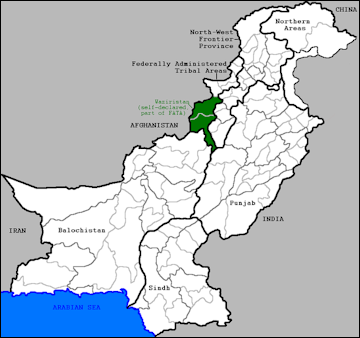AL-QAIDA FLEES AFGHANISTAN FOR IN PAKISTAN IN 2001-2002
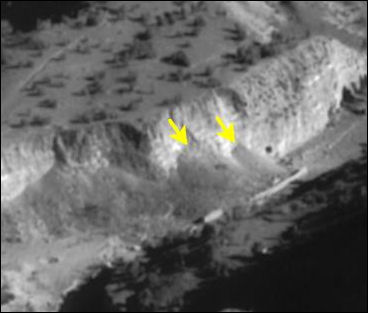
Kili Cave Complex in Afghanistan, post-strike photo After the Tora Bora bombing in December 2001 after the American invasion of Afghanistan , several hundred Al-Qaida fighters close to Osama bin Laden fled south of Gardez, Afghanistan. They were ordered to disperse to their home countries. Many crossed into Pakistan and made their way to Karachi, where they were able to board planes or boats out of Pakistan and make their way home, where they were told to continue their operations against Western targets. The United States believes that several hundred Al-Qaida members slipped into Iran after the fall of the Taliban in Afghanistan.
An estimated 2,000 Al-Qaida fighters are believed to have fled to Pakistan after the American invasion of Afghanistan in 2001-2002. It is widely believed that Osama bin Laden and high-ranking members of Al-Qaida escaped to Pakistan where they regrouped in preparation for new attacks in Afghanistan and in the West. According to U.S. officials, after Al-Qaida escaped from Afghanistan 1,000 to 2,000 Al-Qaida fighters made their home in villages in Pashtun areas in Pakistan near the Afghanistan border and mid-level Al-Qaida leaders and former Taliban officials re-established operation bases inside Pakistan.
Many Al-Qaida members found refuge in Pakistan’s tribal areas, where they were protected by local tribes. Others are hid out in the cities. Al-Qaida used Pakistan as a base for international operations and participated in local attacks in Pakistan using Pakistan militants trained in Afghan and Pakistani camps. At least several hundred Al-Qaida members — perhaps a few thousand — took up residence in the tribal regions of Pakistan near they Afghan border. They were protected by the tribesmen, who have Taliban-like beliefs similar to those of the Al-Qaida members. Many Al-Qaida members are believed to have married local women. One member of the Waziri tribe told the Washington Post, “These are refugees who share our culture; they carry guns and wear beards, so no one can distinguish them. We consider them not foreigners but friends.”
The Al-Qaida fighters included Pakistanis, Arabs, Chechens, Uzbeks, and Uighurs from western China. Many of the Al-Qaida militants in South Waziristan were initially believed to be followers of Uzbek Al-Qaida commander Tahir Yuldashev, a Taliban ally and deputy of the slain Uzbek leader Juma Namangani. Al-Qaida members and Afghan and Pakistani Taliban was able to move relatively easily back and forth across the porous border between Pakistan and Afghanistan in part because for may years the primary focus of the American military was Iraq. The Pakistani military called the Afghan-Pakistani border region treacherous. Their efforts to slow movement often appeared half hearted; American forces in Afghanistan were limited by numbers,
Tribal Zone in Pakistan Where Al-Qaida Found Refuge
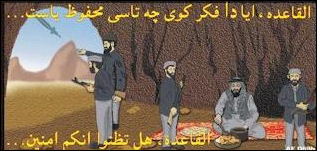
CIA -prepared leaflet
Ahmed Rashid, an expert on the Taliban and Central Asian jihadist groups, wrote in the Washington Post: The "new friendship zone stretches nearly 2,000 miles along Pakistan's Pashtun belt — from Chitral in the Northern Areas near the Chinese border, south through the troubled tribal agencies including Waziristan, down to Zhob on the Balochistan border, then to the provincial capital Quetta and southwest to the Iranian border. The region includes every landscape from desert to snow-capped mountains. Sparsely populated, it provides bin Laden an ideal sanctuary. [Source: Ahmed Rashid, Washington Post, March 1, 2006]
“Al Qaeda's money, inspiration and organizational abilities have helped turn Pakistan's Pashtun belt into the extremist base it is today, but U.S. and Pakistani policies have helped more. Although the Taliban and al Qaeda extremists were routed from Afghanistan by U.S. forces, Secretary of Defense Donald H. Rumsfeld's refusal to put enough U.S. troops on the ground let the extremists escape and regroup in Pakistan's Pashtun belt. The Taliban settled in Balochistan where they had originated before 1994, while al Qaeda members hid in the tribal agencies they knew well. Bin Laden had built tunnels and caves there for the anti-Soviet mujaheddin in the 1980s.
“Bin Laden has fighters and sympathizers down the length and breadth of Pakistan's Pashtun belt. No Pakistani Pashtun has reason to betray bin Laden, despite the $27 million reward for his head. Thanks to the drug trade in Afghanistan and the suitcases full of cash still arriving from backers in the Arabian Gulf, neither al Qaeda nor the local Pashtuns are short money. The Pakistani army's failure to offer Pashtuns a greater political role in the national framework has not inspired any loyalty among the tribesmen. And misguided U.S. interventions, such as the January missile strike that killed women and children, do the rest.” Washington's decision to pull U.S. troops out of Afghanistan has only reinforced al Qaeda's belief that it is winning.
Pakistan Government’s Weak Efforts to Combat Al-Qaida
Waziristan, an Al-Qaida-friendly area of Pakistan Ahmed Rashid wrote in the Washington Post: “For 27 months after the fall of the Taliban regime, Pakistan's president, Gen. Pervez Musharraf, Washington's closest ally in the region, allowed the extremists free rein in the Pashtun tribal areas to re-establish training camps for militants who had escaped Afghanistan. These included Arabs, Central Asians, Chechens, Kashmiris, Africans, Uighurs and a smattering of East Asians. It was a mini-replay of the gathering in Afghanistan after bin Laden arrived there in 1996. [Source: Ahmed Rashid, Washington Post, March 1, 2006]
Musharraf did capture some Arab members of al Qaeda, but he avoided the Taliban because he was convinced that the U.S.-led coalition forces would not stay long in Afghanistan. He wanted to maintain the Taliban as a strategic option in case Afghanistan dissolved into civil war and chaos again. The army also protected extremist Kashmiri groups who had trained in Afghanistan before 9/11 and now had to be repositioned.
Indeed, in March 2002, just three months after the defeat of the Taliban, the United States began to withdraw its Special Forces, surveillance satellites and drones from Afghanistan to prepare for war in Iraq. Distracted by Baghdad, it did not notice what was happening in the tribal agencies. By the time the Pakistan army entered South Waziristan in March 2004, the extremists were so well entrenched that 250 Pakistani soldiers were killed in the first encounters.
Since then, with no consistent political strategy to woo the Pashtun population away from bin Laden, the army has steadily lost ground. The political agents, who ran the tribal agencies with a mixture of bribery and pressure, have been replaced by arrogant generals ignorant of local conditions. Today the extremists rule over North and South Waziristan and other tribal agencies, while the 70,000 Pakistani troops stationed there are boxed up in outposts, too frightened to patrol the mountains. More than 100 pro-government tribal elders have been assassinated by extremists for divulging information to the U.S. or Pakistani secret services.
Western officials have long regarded Pakistani security forces with suspicion, chiefly over their links to militants fighting in Afghanistan. In 2010, U.S. Secretary of State Hillary Rodham Clinton caused anger in Pakistan when she said she found it "hard to believe" that no one in Islamabad knows where the al-Qaida leaders are hiding and couldn't get them "if they really wanted to." But at the same time al-Qaida has been responsible for scores of bloody attacks inside Pakistan, including on its army and civilian leaders. [Source: Nahal Toosi and Zarar Khan, Associated Press, May 3, 2011]
Al-Qaida Protected in Pakistan?
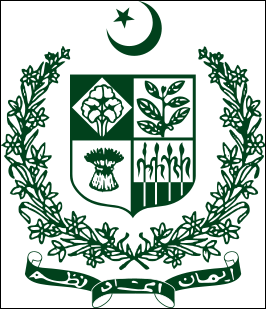
Pakistan Intelligence Service Jane Mayer wrote in The New Yorker: The Indian “intelligence service has devoted considerable energy to discovering links between Al Qaeda and Pakistani extremist groups that oppose India’s presence in Kashmir. (Bin Laden has championed the cause of Kashmiri independence.) Many of the Pakistani groups, the Indians say, have received covert support from the country’s military and intelligence apparatus. An Indian intelligence official emphasized that Abu Zubaydah, a Saudi-born Palestinian who had assumed one of the highest posts in Al Qaeda’s chain of command, was found in the northeast city of Faisalabad, in a villa owned by a Pakistani jihadi organization called Lashkar-e-Taiba. In addition, Khalid Shaikh Mohammed, whose family is from Balochistan, was found in March living with a member of the Jamaat-e-Islami Party — part of the militant coalition that Musharraf lost ground to in the last election. The safe house was in Rawalpindi, a well-heeled town outside Islamabad that is home to much of Pakistan’s military. Indeed, the villa is a quick walk from Musharraf’s own house, and its back yard faces a military training ground. [Source: Jane Mayer, The New Yorker, July 28, 2003]
“Asad Hayauddin [a Pakistani diplomat] told The New Yorker that a United States military presence in the tribal areas “would be very unwelcome. There is great resistance to the idea of foreign occupation of any sort.” He added, “You have to deal with this area politically, not militarily. That’s why the U.S. is having such problems. They don’t have an anthropological approach to world problems. If you take an armored personnel carrier, or a helicopter gunship, you kill innocent people. Then you’ve lost that village for a hundred years. These places run on revenge.”
“The Pakistani government has tried to advance this argument in Washington, encouraging a less confrontational strategy in the tribal regions. In December, 2001, according to several knowledgeable sources, Musharraf met with Wendy Chamberlin, then the American Ambassador to Pakistan, and asked for American support in helping him extend his control over the tribal areas. He argued that, unless the borders were cauterized there, the flow of fighters from. Afghanistan would be impossible to stop. Musharraf told Chamberlin that the local Pashtun people could be bought off with basic government services that their tribal leaders had never provided’such as schools, clinics, roads, and water. Large cash awards could be offered to locals who helped track down fugitive Arabs. “How much do you need?”
“Chamberlin asked. Musharraf’s answer was forty million dollars. Chamberlin told Musharraf that she would back his plan. But when her funding request reached Congress, it was derailed. Charlie Flickner, the powerful Republican clerk of the foreign-operations subcommittee of the House Appropriations Committee, felt that the expenditure was a waste of money. He had travelled to western Pakistan, and concluded that the tribal areas were essentially sinkholes. One Democrat, however, told me, “We blew it. There was a window of opportunity, but we lost it by not funding them adequately.” Soon after Chamberlin’s proposal was dismissed, the North-West Frontier Province fell into the hands of Musharraf’s Islamist opponents; in the tribal areas, fundamentalists further expanded their influence.
Al-Qaida in Pakistan After September 11th

Pashtun fighters in the Afghan-Pakistan
border region in the Mujahideen era In the 2000s, Al-Qaida was very strong in Pakistan. They were believed to be hiding out in Karachi, around Quetta, in Wazaristan, around Peshawar in Balochistan, and various places in the Tribal Areas in the North-West Frontier in Pakistan. In some of these places there have been fire fights between Al-Qaida and Pakistani security forces and air strikes by CIA drones.
Al-Qaida members in Pakistan often lived as “honored guests” and live quite openly and comfortable among people who are devoted to Islam and have never heard of the World Trade Center. There are also many Al-Qaida at the madrassahs. In some places people fly the Taliban flag openly and brag about their association with Al-Qaida.
After September 11th “Al Qaeda did not hesitate to assert itself, “ Newsweek reported. “Jihadists paraded brazenly in Waziristan, dragging "criminals" through the streets. American satellite photos soon showed single files of foreign jihadists, their feet sometimes wrapped in plastic bags against the snow, crossing the Pakistani border into Afghanistan. An Algerian man known as "the Bombmaker," a seasoned veteran of Iraq, set up shop to teach jihadists how to build IEDs. Local militants ruled through assassination and intimidation. An experienced Western military official interviewed by Newsweek described how militants killed a petty merchant and his entire family simply for selling watermelons to the local constabulary. "Imagine what they'd do to the guy who sells out Osama," said the officer. [Source: Newsweek, Reported by Ron Moreau and Sami Yousafzai on the Afghanistan-Pakistan border; Zahid Hussain in Islamabad; Rod Nordland in Tora Bora; Mark Hosenball, Michael Hirsh, Michael Isikoff, John Barry, Dan Ephron and Eve Conant in Washington; Christopher Dickey in Paris, and Roya Wolverson in New York. Written by Evan Thomas. September 3, 2007]
AP reported: “A July 2007 assessment from U.S. counterterrorism analysts — entitled "Al-Qaeda Better Positioned to Strike the West" — said that al-Qaeda has used its safe haven along the Afghan-Pakistan border to restore its operating capabilities to a level unseen since the months before Sept. 11, 2001. The findings suggests that the network has been able to regroup despite nearly six years of bombings, war and other tactics aimed at dismantling it. [Source: AP, July 12, 2007]
Al-Qaida in Afghanistan After September 11th
Pashtun fighter from
the Mujahideen era After the American invasion of Afghanistan in 2001-2002 Al-Qaida remained active in Taliban-controlled mountains of Khost area near the Pakistan border and felt free enough there to use satellite phones even though they knew the calls were being monitored by U.S. surveillance. Ties between Al-Qaida and the Taliban were strong. Members of the groups often met openly.
Within a year after the main American offensive ended and the Taliban was ousted from Kabul, some old Al-Qaida camps in eastern Afghanistan were reactivated and Al-Qaida members moved around somewhat openly in parts of Afghanistan and Pakistan. The bazaar town of Angurada in Afghanistan was labeled by some as Al-Qaida town because so many Al-Qaida members were running around.
Jane Mayer wrote in The New Yorker: “Al Qaeda is clearly good at finding hiding places. The Times recently reported that, after a shoot-out in the mountains of Afghanistan...American soldiers were amazed to find a kitchen big enough to feed forty people, complete with a cow, several donkeys, and a larder, hidden behind a false wall in a cave. Searching bin Laden’s cave network in Tora Bora, in the White Mountains, analysts have found artillery, tank parts, and computers. [Source: Jane Mayer, The New Yorker July 28, 2003]
Peter Bergen wrote in the Washington Post: “The rapidly deteriorating security situation in Afghanistan” has been “in part, the responsibility of al-Qaeda. The use of suicide attacks and makeshift bombs and the beheadings of hostages — all techniques that al-Qaeda perfected in Iraq — are methods that the Taliban has increasingly adopted in Afghanistan, making much of the south of the country a no-go area. [Source: Peter Bergen, Washington Post, July 2, 2006]
Hekmat Karzai, an Afghan terrorism researcher at the Institute of Defense and Strategic Studies in Singapore, points out that suicide bombings were rare in Afghanistan until 2005, when 21 such attacks took place. In the first half of 2006 there had already seen at least 16. In addition, Karzai reports that two of al-Qaeda's "most able" commanders — Khalid Habib, a Moroccan, and Abd al Hadi, an Iraqi — have been appointed to run its operations in southeastern and southwestern Afghanistan. These developments suggest that al-Qaeda is regrouping and strengthening along the Afghan-Pakistan border.
Al-Qaida Activities in Pakistan After September 11th
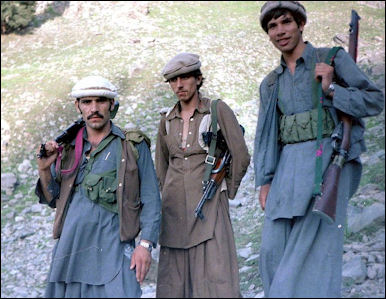
Pashtun fighters Al-Qaida is believed to be connected in varying degrees and ways to the numerous suicide bombings, assassinations, terrorist attacks and militant attacks that have taken place in Pakistan in recent years. Many of the attacks appear to be carried out by groups sympathetic to Al-Qaida not by Al-Qaida itself. Pakistan is one of the nations, along with Morocco, Saudi Arabia, Yemen and Jordan, that Osama bin Laden accused of having an “oppressive, unjust, apostate ruling government” and being “enslaved by America” and therefore “eligible for liberation.”
In September 2003, al-Qaida deputy leader Ayman al Zawahiri urged Pakistanis to overthrow Musharraf for his support of the United States. Al-Qaida is believed to have been involved in two unsuccessful assassination attempts of Musharraf and the successful assassination Benazir Bhutto in December 2007.
According to a 2008 Pentagon report: Pakistan increased its troop levels in the border areas by 30,000 last year, and made “significant and costly” efforts to eliminate safe havens” yet “It is troubling that despite these efforts, safe havens in the FATA [Federally Administered Tribal Areas] have grown in recent years.” [Source: AFP, May 25, 2008]
The Pentagon report noted that 700 Pakistanis have been killed in suicide attacks between July 2007 and May 2008 and “Al-Qaeda and other violent extremists continue to hide out in the FATA, where they are able to recruit, train and target US and western interests, including plots against Europe and the US homeland.” Madrasahs, or Islamic religious schools, “continue to promote jihad and martyrdom, and provide potential operatives for acts of violence in Afghanistan,” it said. “Despite successful attacks against some terrorist training facilities in the tribal areas, it is believed other camps remain active and safe havens have grown in recent years,” it said.
Support of Al-Qaida by Local Tribesman and Lack of U.S. Support to Hunt Them Down

Pashtun farmers Many local people in the tribal areas of Pakistan have fought in defense of Al-Qaida members. One Waziri tribesman told the Washington Post, “The wanted men are few, but the resistance is high, because we are especially angry. The tribes were used by the government to fight in Afghanistan, and now people feel they are being sold out too the United States in the name of Al-Qaida.”
Some have wondered if military incursions into tribal areas have done more harm than good, stirring up resentment among the tribal people and yielding few arrests of top level Al-Qaida members. One tribesman told the Washington Post, “the government says Al-Qaida is over there, but that is only because of American pressure. There is no Al-Qaida. There are no foreign terrorists. The army is bombing the homes and families of anyone who has a beard. If they keep doing these attacks the entire tribal belt will rise up in resistance.”
A Waziri shopkeepr told the Washington Post, “These men are holy warriors and we respect them. Everyone wants “sharia” to be implemented here. We have no problem with this so-called Al-Qaida. We know America is against Islam, and we need someone to defend us.”
Many Al-Qaida members take advantage to the tradition of hospitality to seek find refuge, sometimes calling themselves itinerant Islamic proselytizers. A Pakistani politician told the Washington Post, “It’s ingrained. The guest is a very honored commodity; we have to look after them. Even if I know this person had committed 20 murders across the road if he asks for protection, I’m sorry, I have to give him protection — until someone comes for him and we sit down and talk.”
The Iraq War sucked away resources that could have been used to more effectively go after Al-Qaida in Pakistan and Afghanistan. Newsweek reported: “In 2005, the CIA gave President Bush a secret slide show on the hunt for bin Laden. The president was taken aback by the small number of CIA case officers posted to Afghanistan and Pakistan. "Is that all there are?" the president asked, according to a former intelligence official. [Source: Newsweek,. September 3, 2007]
Al-Qaida in Balochistan

Tribal and religious leaders Ahmed Rashid wrote in the Washington Post: “Meanwhile down south, the Balochistan provincial government is controlled by a coalition of pro-Taliban fundamentalist parties, which came to power in elections in 2002. Jamiat-e-Ulema-i-Islami, the party that controls the key ministries, openly supports the Taliban. [Source: Ahmed Rashid, Washington Post, March 1, 2006]
“This has created a new stronghold from which the Taliban can launch attacks back in Afghanistan. The 99 U.S. soldiers killed last year in 2005 were mostly targeted by the Taliban based in Balochistan. While Washington's principal aim has been to capture bin Laden and decapitate al Qaeda, whose members are believed to be in Waziristan, the United States has failed to pressure Pakistan to deal with the Taliban, despite protestations from Afghan President Hamid Karzai. On one visit to Islamabad, Karzai handed Musharraf intelligence dossiers detailing how suicide bombers are being trained in Pakistan. The dossiers listed the names and addresses of Pakistani recruiters and people who equip suicide bombers with explosives before sending them to Afghanistan. Much of the recruitment takes place at a radical Islamic bookshop, several mosques and some madrassas in the port city of Karachi, while the training is done at safe houses in Quetta and Chaman, in Balochistan province.” "We have provided President Musharraf with a lot of very detailed information on acts of terrorism . . . and we discussed in great detail what actions Pakistan could now take," Karzai told Rashid.
John Christopher Turner, a self-described filmmaker, took footage of Taliban holdouts and the al Qaeda operatives who were funding them in May, 2002 in Balochistan province. Balochistan, Turner told the Washington Post, "is where the Taliban and al Qaeda are comfortably living right now. There's nobody trying to run them off. In fact, they're honored guests...I probably went to 10 hornets' nests and there were always two or three al Qaeda in supervisory positions — overseeing, I'd say; the last thing you can do is boss a Pashtun. But obviously they were conduits for money." He added, however, that he met al Qaeda operatives elsewhere in Pakistan as well. "There are madrassas [Islamic schools] right outside Karachi that are full of al Qaeda," Turner said in a telephone interview from Kansas City, where he is doing construction work and waiting for the film, titled "Hashassins," to be edited. "You go to any madrassa and the al Qaeda are out there."
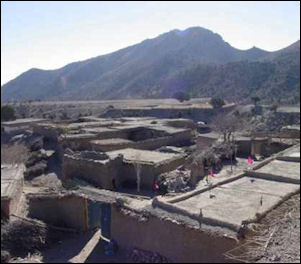
Village used by al Qaeda “Traveling with armed tribesmen into areas where Taliban and al Qaeda have found refuge,” Karl Vick wrote, “Turner told of Arab extremists living openly among their local supporters, many of whom live such isolated lives they do not know the cause of the current fighting.” "They're being misrepresented," Turner said of the many Pashtuns who understand the conflict entirely as a war on Islam. "Most of the Pashtun don't know about the trade towers," referring to the Sept. 11 terrorist attacks in the United States. The "hundreds" of Taliban holdouts he saw in Balochistan made no effort to hide their presence there. Balochistan borders the southern Afghan province of Kandahar, birthplace of the Taliban. "They're not shy," Turner said. He said that shopkeepers in Quetta, near the Afghan border, are asked to contribute to the resistance. As for the presence of al Qaeda, "they were proud of it," Turner said. [Source: Karl Vick, Washington Post, August 4, 2002]
"I had long, probing conversations with these al Qaeda people," Turner said. The Arabs, he said, abhorred what they regarded as the corrupting influence of Western money and morals on traditional Muslim societies and Arab governments, especially in Saudi Arabia, site of two of Islam's three holiest cities. "Their attack on the trade towers, in talking to them, was an effort to do that, to break down that economic base," he said. The argument, if not the action itself, resonated with Turner. He settled in Afghanistan in the 1970s, converting to Islam and eventually fighting the Russians alongside the mujaheddin after being captivated by a tribal culture that had changed little in hundreds of years. "They don't want their world polluted," Turner said of the Arabs. "They see us as the greedy people that we are. Turner said he eased his passage into the area by introducing himself to a Baluchi clan chief in Karachi, who provided the small armed escort that signaled the American was under his protection.
Iraq and Al-Qaida
In 2003, top Al-Qaida leaders met with top Taliban leaders and told them that it was reducing monetary support of jihadists in Afghanistan to $3 million a month, half what they got before, and diverting foreign militants to new locations so the money and personnel could be focused on Iraq instead. Large numbers of fighters took overland routes through Iran from Afghanistan to Iraq. A Taliban member at the meeting told Newsweek that representatives from Osama bin Laden said that money was tight and “the spilling of American blood is easy in Iraq.”
There was some rivalry between Al-Qaida leader Al-Zawahiri and Abu Mousab al-Zarqawi in Iraq. On several occasions Zawahiri scolded Zarqawi for his brutal methods. In a message released in October 2005, Zawahira attacked the killing of Shiite civilians and cutting off heads of Western hostages because it eroded support from ordinary Muslims. After Zawahiri wrote a letter to Zarqawi, gently suggesting that he stop his habit of beheading hostages because it was turning off many Muslims, Zarqawi stopped the beheadings.
For a time it seemed that Al-Qaida in Iraq wanted to provoke civil war in Iraq. Also in 2005, Atiyah abd al-Rahman, one of Osama bin Laden’s top aides, sent a message to Abu Musab al-Zarqawi, chiding him for targeting Shiite Muslims in his scorched-earth campaign in Iraq against America and its allies.
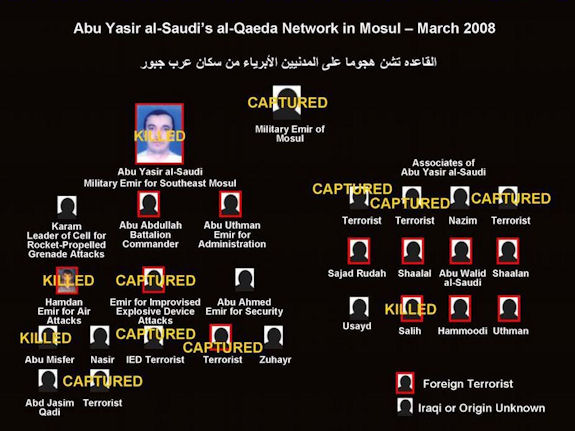
Al-Qaida In Iraq Mosul Network 2008
Al Qaida as an Organization after September 11th
When the United States struck Afghanistan in 2001, "there were probably 3,000 core Al Qaeda operatives," John Arquilla of the Naval Postgraduate School told Newsweek. "We killed or captured about 1,000; about 1,000 more ended up in distant parts of the world. And about 1,000 ended up in Waziristan. But the great terror university in Afghanistan is gone; they've relied on the Web since. They haven't had the hands-on instruction and the bonding of the camps. That's resulted in low-skill levels. Their tradecraft is really much poorer." [Source: Newsweek, September 3, 2007]
In 2003, it was estimated that Al-Qaida had about 3,000 members. Between 2002 and 2005, according to the New York Times, Al-Qaida was involved in 17 bombings that killed more than 700 people — more attacks and victims than all the years before September 11th. Most of the attacks and victims were in Iraq. In recent years the majority of Al-Qaida-linked attacks have occurred in Pakistan and Afghanistan.
According to United Nations report released in December 2002, Al-Qaida remained a formidable presence in 40 countries and was attracting lots of volunteers. It said progress had been made breaking existing Al-Qaida cells and freezing its financial assets but these successes had been offset by the recruitment of more volunteers that promised to keep the organization going in the future.
According to a report released in April 2006 leaders of Al-Qaida had lost some control due to arrests and deaths of top operational planners; Al-Qaida’s leaders were largely on the run; relations between Al-Qaida and the Taliban were strained; and the group’s financed and logistics had been disrupted. But, the report added that the group “will go through several more changes” and will be “a resilient enemy for years to come.” The also said Al-Qaida found it harder to mount spectacular attacks because it was so closely watched.
A new generation of terrorists, many of them recruited and trained using the Internet, came on line. A massive recruiting drive took place during the Iraq war. These new recruits worked in small, local groups that were difficult to detect and respond to. There has been an effort to recruit more non-Arabs who would be less likely to arouse suspicion by security personnel.
Al-Qaida’s Changing Tactics
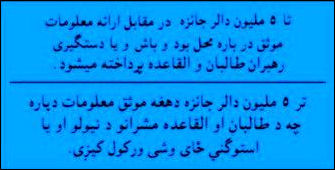
bounty leaflet Intelligence officials have warned of Al-Qaida’s ability to adapt. In an annual "threat assessment" to Congress, the Washington Post reported, spy agencies described the emerging threat as more geographically dispersed and also low-tech, favoring lone operatives and conventional explosives. [Source: Joby Warrick and Peter Finn, Washington Post, February 8, 2010]
Director of National Intelligence Dennis C. Blair, told the Washington Post that attacks like the attempted bombing of Northwest Airlines Flight 253 over Detroit is emblematic of an evolving threat that relies on "small numbers of terrorists, recently recruited and trained, and short-term plots." The new tactics are less spectacular but also much harder to detect and disrupt, he said. A handful of individuals and small, discrete cells will seek to mount attacks each year, with only a small portion of that activity materializing into violence against the homeland.” But at the same time, as Al-Qaida has become decetralized it has become more prone to internal disputes and harder coalesce to pull off spectacular attacks.
On Al-Qaida’s new strategy Bruce Hoffman wrote in the Washington Post: “First, al Qaeda is focused on overwhelming, distracting and exhausting us. It seeks to flood our information-overloaded national intelligence systems with myriad threats and background noise so we overlook key clues, such as those before Christmas that linked Abdulmutallab to an al Qaeda airline-bombing plot. Second, al Qaeda stepped up a strategy of economic warfare, issuing statements, videos and audio messages online trumpeting its actions against Western financial systems, even taking credit for the economic crisis. Propaganda doesn't have to be true to be believed. “Heightened security measures after the Christmas Day plot, plus the likely development of ever more sophisticated passenger-screening and intelligence technologies, stand to cost a lot of money, while the war in Afghanistan constitutes a massive drain on American resources. Given the economic instability here and abroad, al Qaeda's strategy of financial attrition could pay outsize dividends. [Source: Bruce Hoffman, Washington Post , January 15, 2010]
“Third, al Qaeda still seeks to divide the global alliance arrayed against it by targeting key coalition partners. Terrorist attacks on mass-transit systems in Madrid in 2004 and London in 2005 were intended to punish Spain and Britain for participating in the war in Iraq and in the U.S.-led war on terrorism. During the past two years, serious terrorist plots orchestrated by al Qaeda's allies in Pakistan, meant to punish Spain and the Netherlands for participating in the war on terrorism, were thwarted in Barcelona and Amsterdam. In Afghanistan, suicide bombers and roadside explosives target contingents from countries such as Britain, Canada, Germany and the Netherlands, where popular support for deployments has waned, in hopes of hastening their withdrawal from the NATO-led coalition.
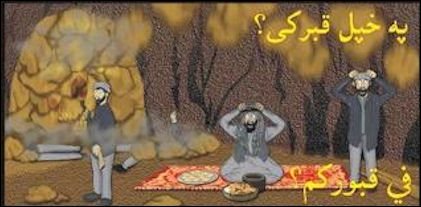
CIA -prepared leaflet
“Fourth, al Qaeda aggressively seeks out, destabilizes and exploits failed states and other areas of lawlessness to extend its reach and conducts local campaigns of subversion to hasten their decline. It increased activities in places such as Pakistan, Algeria, the Sahel, Somalia and especially Yemen. It guides allies and related terrorist groups, boosting their local, regional and — as the Northwest Airlines plot showed — international attack capabilities. The exact number of al Qaeda personnel in each of these areas varies, sometimes including no more than a few hard-core terrorists. But they perform a critical force-multiplying function by providing weapons, training and intelligence for attacks to indigenous terrorist groups — and by disseminating propaganda, building Web sites and launching online magazines modeled on al Qaeda's.
“Fifth, al Qaeda seeks recruits from non-Muslim countries — especially converts to Islam whose appearances and names would not arouse the same scrutiny that persons from Islamic countries might — as the ultimate fifth columnists. Citizens of countries that participate in the U.S. visa-waiver program are especially prized because they can move freely between Western countries and blend easily.
A survey of terrorist incidents in 2009 underscores al Qaeda's diversity of threats and tactics: 1) Hard-core operatives as Humam Khalil Abu-Mulal al-Balawi, the double agent who played U.S. and Jordanian intelligence to kill more CIA agents than anyone else has in more than a quarter-century. 2) Sleeper agents such as David Headley, the U.S. citizen whose reconnaissance efforts for longtime al Qaeda ally Lashkar-i-Taiba were pivotal to the November 2008 suicide assault in Mumbai. 3) Motivated recruits such as Abdulmutallab, the alleged Northwest Airlines bomber, and Najibullah Zazi, the Afghan-born U.S. resident arrested in New York last September and charged with plotting a "Mumbai on the Hudson" suicide terrorist operation. 4) "Lone wolves" such as Maj. Nidal Hassan, accused of killing 13 people at Fort Hood in November, and Abdulhakim Muhammad, a convert to Islam who, after returning from Yemen last June, killed one soldier and wounded another outside an Army recruiting center in Little Rock.
Al-Qaida in Pakistani Become More Pakistani, and Goes After More Pakistani Targets
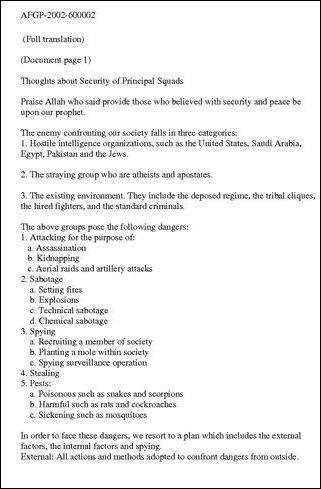
Translation of Al-Qaida memo
on Thoughts About Security
of Principal Squads
Carlotta Gall wrote in the New York Times: The Qaeda network accused by Pakistan’s government of killing Benazir Bhutto is increasingly made up not of foreign fighters but of homegrown Pakistani militants bent on destabilizing the country, analysts and security officials here say. In previous years, Pakistani militants directed their energies against American and NATO forces across the border in Afghanistan and avoided clashes with the Pakistani Army.But in 2007 they have very clearly expanded their ranks and turned to a direct confrontation with the Pakistani security forces while also aiming at political figures like Ms. Bhutto, the former prime minister who died when a suicide bomb exploded as she left a political rally. [Source: Carlotta Gall, New York Times, December 30, 2007]
“Al Qaeda seems to have turned its face toward Pakistan and attacks on the Pakistani government and Pakistani people,” Defense Secretary Robert M. Gates said. The expansion of Pakistan’s own militants, with their fortified links to Al Qaeda, presents a deeply troubling development for ...this volatile nuclear-armed country. Al Qaeda in Pakistan now comprises not just foreigners but Pakistani tribesmen from border regions, as well as Punjabis and Urdu speakers and members of banned sectarian and Sunni extremists groups, Najam Sethi, editor of The Daily Times, wrote in a front-page analysis. “Al Qaeda is now as much a Pakistani phenomenon as it is an Arab or foreign element,” he wrote.
The tribes on the border have a long history of fighting invading armies. But since 2001, when Qaeda and Taliban forces fled the American intervention in Afghanistan and took refuge in Pakistan’s tribal areas, the Pakistani militants have steadily grown in strength and boldness. Today they have been bolstered by the foreigners among them. Those include a smaller number of hard-core Arabs, like Osama bin Laden and Ayman al-Zawahri, Al Qaeda’s second in command, as well as a larger number of Uzbeks, Tartars and Tajiks who have influence them to take on new agendas, Pakistani security officials familiar with the region said.
The Arabs in particular have brought money and fighting and explosives expertise, as well as ideology that includes religious justifications of tactics like suicide bombings and beheadings, which Afghans and Pakistanis had not used before, they said. More and more, those tribes and foreign networks have overlapping operations and agendas. “The country is facing the gravest challenge from these terrorists and extremist elements,” Brig. Javed Iqbal Cheema, the director of the National Crisis Management Cell and main spokesman for the Interior Ministry, said Friday as he accused Al Qaeda of Ms. Bhutto’s assassination. “They are systematically targeting our state institutions in order to destabilize the country.”
Al-Qaida Becomes More Decentralized and Grows by Adding Affiliates
In the 2000s Al-Qaida, became more decentralized and gave more power to operational lieutenants who operated in their own sphere, scattered around the globe, and ran their own terrorist operations with assistance of Al-Qaida. Time described Al-Qaida as having “morphed from a highly hierarchal organization into a multi-headed hydra, with independently operating cells. The glue that hold them together is jihadist ideology.”After September 11th Al-Qaida lacked a clear chain of command. This made it more difficult for authorities to suss out what is going on in the organization but it also made it harder for the organization to remain cohesive as different leaders — including Zawahiri, Abu Musab Zarqawi in Iraq and Osama bin Laden — competed for dominance and relevance. When Al-Qaida was most active in Iraq was fighting between Zawahiri and Zarqawi over tactics while Osama bin Laden expressed concern was largely above the fray and isolated.
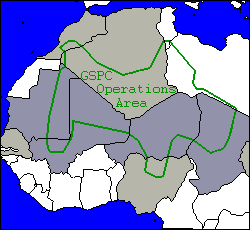
Al-Qaida-lined group
in the western Sahara Josh Meyer wrote in the Los Angeles Times: “Secure in its haven in northwestern Pakistan, a resurgent Al Qaeda is trying to expand its network, in some cases by executing corporate-style takeovers of regional Islamic extremist groups, according to U.S. intelligence officials and counter-terrorism experts. Though not always successful, these moves indicate a shift in strategy by the terrorist network as it seeks to broaden its reach and renew its ability to strike Western targets, including the United States, officials and experts say. "Certainly we do see Al Qaeda trying to influence the broader movement and to control some of these affiliates in a more direct way," a senior counter-terrorism official in the Bush administration told the Los Angeles Times. "The word I would use is 'co-opt' . . . as opposed to simply associating with or encouraging. By that I mean target selection, types of attacks, methodology, funding, all of the things that would make an affiliate suddenly a subsidiary."
[Source: Josh Meyer, Los Angeles Times, September 16, 2007]
“Al Qaeda's efforts do not always pan out. In some cases, it has pulled back after making an initial approach. And some groups have rebuffed Osama bin Laden's organization. Sometimes, it is not clear exactly what influence senior Al Qaeda leaders have. Three men arrested in Germany in September 2007 for allegedly plotting attacks there against Americans have been linked to an extremist group based in Uzbekistan that broke away from an organization long under Al Qaeda's umbrella. Authorities fear that the group, the Islamic Jihad Union, might have been drawn tightly into Al Qaeda's orbit and aimed far beyond its previous targets in Central Asia. [Source: Josh Meyer, Los Angeles Times, September 16, 2007]
“From its early years in the 1990s, Al Qaeda has been an umbrella organization of groups in Pakistan, Egypt, Saudi Arabia and other countries that has fostered symbiotic relationships with like-minded militant organizations without necessarily directing their operations. Al Qaeda's links to many outlying parts of its network were severed after the post-Sept. 11 attacks. Signs of the rebuilding effort began to become apparent around 2005 and intensified significantly after that. U.S. intelligence and counter-terrorism officials say they have seen indications in numerous terrorist plots and attacks and other extremist violence in Africa, the Middle East, Asia and Europe.
In congressional testimony, FBI Director Robert S. Mueller III said Al Qaeda's "mergers with regional groups . . . have created a more diffuse violent Islamic extremist threat that complicates the task of detecting and deterring plots against the homeland." U.S. officials and private experts described it as a two-way process in which Al Qaeda leaders in Pakistan, including chief strategist Ayman Zawahiri....reach out to the groups, sending them emissaries and providing them with financing, logistical support and training. And they said the groups were also reaching out to Al Qaeda, sending their recruits to Pakistan for training and indoctrination. U.S. officials say these liaisons combine Al Qaeda's money, training, finely honed tactics and muscle with the widespread support and participation that the local and regional groups enjoy from within their communities.
“Some of those groups have jumped at the chance to align themselves with the Al Qaeda "brand name," which has soared in popularity because of its increasingly sophisticated multimedia campaigns and widespread opposition to U.S. foreign policy, particularly the war in Iraq, the officials and private experts say. The most clear-cut example is that of Al Qaeda in the Islamic Maghreb, an extremist group previously known as the Salafist Group for Call and Combat, known by the French acronym GSPC. The earlier group consisted mostly of Algerians bent on overthrowing their own government.
In September 2006, “Zawahiri announced that the group had became Al Qaeda's affiliate in the North African region to become "a bone in the throat of the American and French crusaders." "They had people but they had no arms, no training and no money. By pledging allegiance, they got all of those," one recently departed State Department counter-terrorism official said. In return, Al Qaeda "got more juice" in the form of frequent attacks on Western targets that raised its visibility, the official said. By mid 2007 Al Qaeda in the Islamic Maghreb was launching as many as four attacks a week, often suicide bombings against Western targets and political enemies, including what intelligence officials believe was an attempt to assassinate Algerian President Abdelaziz Bouteflika. That bombing killed at least 20 people. The group now is active throughout much of North Africa and the sub-Saharan Sahel region. Al Qaeda leaders in Pakistan are using the network's contacts and foot soldiers in North Africa and in Spain and other parts of Europe.
“Al Qaeda's expansion efforts in some cases have encountered resistance. In Southeast Asia, some groups have rejected advances by its affiliates Abu Sayyaf in the southern Philippines and Jemaah Islamiah, the senior administration official said. In Iraq, Al Qaeda's Pakistan-based leadership moved aggressively to exert more control over foreign fighters, sending Abu Ayyub Masri from Pakistan after Abu Musab Zarqawi, the leader of a group calling itself Al Qaeda in Iraq, was killed in a U.S. airstrike last year. Masri, who had been in charge of Al Qaeda's overseas networks, is considered more loyal to Al Qaeda than Zarqawi was. But Al Qaeda in Iraq remains largely independent and consists mainly of local Iraqi insurgents, say U.S. intelligence officials. Some local tribal leaders have allied themselves with the U.S. military to counter the group's advances.
New Generation at Al-Qaida

Adam Yahiye Gadahn,
American active in Yemen Marc Sageman wrote in the Washington Post: “Such key 9/11 plotters as Mohamed Atta, Ramzi Binalshibh, Ziad Jarrah and Marwan al-Shehhi met and became radicalized as students in Hamburg, then went to Afghanistan looking for al-Qaeda. But over the past six years, most of the professional terrorists who fit this profile have been eliminated during the U.S.-led manhunt for "high-value targets." The few that remain are huddled in the Afghan-Pakistani border area, struggling to extend their reach beyond Pakistan. [Source: Marc Sageman, Washington Post , June 8, 2008; Sageman is a sociologist, forensic psychiatrist and scholar in residence at the New York Police Department. He is the author of "Understanding Terror Networks" and "Leaderless Jihad."]
“That old guard is still dangerous and still plotting spectacular attacks. But it is the new wave that more urgently requires our attention. This cohort is composed of homegrown young wannabes who dream of glory and adventure, who yearn to belong to a heroic vanguard and to root their lives in a greater sense of meaning. Inspired by tales of past heroism, they hope to emulate their predecessors, even though, for the most part, they can no longer link up with al-Qaeda Central in the Pakistani badlands. Their potential numbers are so great that they must now be seen as the main terrorist threat to the West.
“Unlike their pre-9/11 predecessors, today's would-be terrorists are usually the poorly educated teenage children of unskilled and secular Muslim immigrants. They have been born, raised and radicalized in their host countries (unlike, say, Atta, an Egyptian who recoiled at modern Germany). This new generation's youth culture celebrates a sort of "jihadist cool." Consider the "Hofstad Netwerk" in the Netherlands, which I believe is typical of this new wave. It consists mostly of young people who were born in Holland or immigrated to that country very early in life. They met around their neighborhoods, in Internet cafes or in online chat rooms, then self-radicalized through their admiration for the supposed Islamist heroes fighting the West. One man linked to this cohort, Mohammed Bouyeri, repeatedly shot the Dutch filmmaker Theo van Gogh in 2004 on an Amsterdam street. Other members of this informal network reportedly planned to murder prominent Dutch politicians and bomb the Dutch parliament, a nuclear power plant and Amsterdam's international airport.
“Unlike their fanatical predecessors in the old al-Qaeda, the new terrorists are not particularly religious. The defendants in the Hofstad trials, the March 2004 Madrid bombing trial, the Toronto case and the many trials in Britain are not intellectuals, let alone Islamic scholars. Many became religious only a few months before their arrests, and some are not religious at all. The new generation is not likely to be swayed by abstract arguments. Young jihadist wannabes do not go to Iraq to have theological debates; they go there to blow themselves up.”
Decline of Al-Qaida and the Failure of Achieving Osama bin Laden’s Goals
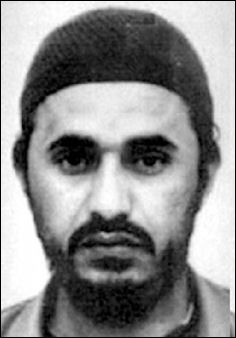
Zarqawi Peter Bergen wrote in Washington Post: “Bin Laden's main goal was to bring about regime change in the Middle East and to replace the governments in Cairo and Riyadh with Taliban-style theocracies. He believed that the way to accomplish this is to attack the "far enemy" (the United States), then watch as the supposedly impious, U.S.-backed Muslim regimes he calls the "near enemy" crumble. [Source: Peter Bergen, Washington Post, August 17,2008]
“This might have worked if the United States had turned out to be a paper tiger that could sustain only a few blows from al-Qaeda. But it didn't. Bin Laden's analysis showed no understanding of the vital interests — oil, Israel and regional stability — that undergird U.S. engagement in the Middle East, let alone the intensity of American outrage that would follow the first direct attack on the continental United States since the British burned the White House in 1814.
“In fact, bin Laden's plan resulted in the direct opposite of a U.S. withdrawal from the Middle East. The United States now occupies Iraq, and NATO soldiers patrol the streets of Kandahar, the old de facto capital of bin Laden's Taliban allies. Relations between the United States and most authoritarian Arab regimes, meanwhile, are stronger than ever, based on their shared goal of defeating violent Islamists out for American blood and the regimes' power.
Feuds Within Al-Qaida Between the Egyptian and Libyan Factions and Over Al-Qaida in Iraq’s Brutal Tactics
In the early days of Al-Qaida Egyptians dominated its upper ranks. As time went on their numbers were depleted and Libyans were promoted and occupied many high-level positions, with some feuds broking out between the Egyptian faction and the Libyan faction. In 2007, after three long years of silence, Osama bin Laden suddenly released a video and two audiotapes in the course of month, apparently to address the division, and rumors that his role in Al-Qaida was being reduced, or maybe he was even dead. [Source: Newsweek, September 28, 2007]
Omar Farooqi, a Taliban liaison officer with Al Qaeda, told Newsweek bin Laden spoke out after he learned that a faction within his own organization had been conspiring to sideline him. Farooqi refused to say which faction bin Laden believed was responsible for the so-called conspiracy, though several Taliban sources pointed to Ayman Al-Zawahiri, bin Laden's deputy, suggesting that he might have been trying to solidify his own authority.
In 2007 Farooqi and other Taliban sources told Newsweek that a split had emerged in Al Qaeda between the organization's powerful Egyptian faction, led by Zawahiri, and its Libyan wing over jihadist strategy. Ever since the 2001 collapse of the Taliban, Zawahiri has been plotting to kill his nemesis, Pakistani President Pervez Musharraf, narrowly missing twice in 2003. But the Libyans, led by Abu Yahya al-Libi, had argued that Al Qaeda's resources should be focused on supporting insurgents in Afghanistan and Iraq and fomenting terrorism in the West.
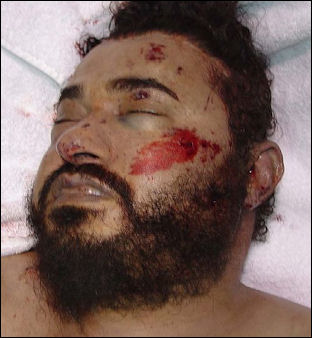
Zarqawi dead There was some rivalry between Al-Qaida leader Al-Zawahiri and Abu Mousab al-Zarqawi in Iraq. On several occasions Zawahiri scolded Zarqawi for his brutal methods. In a message released in October 2005, Zawahira attacked the killing of Shiite civilians and cutting off heads of Western hostages because it eroded support from ordinary Muslims. After Zawahiri wrote a letter to Zarqawi, gently suggesting that he stop his habit of beheading hostages because it was turning off many Muslims, Zarqawi stopped the beheadings.
Six months before the death of Abu Musab al-Zarqawi, the Jordanian leader of Al-Qaida in Iraq, in June 2006, a senior al-Qaeda figure warned him in a letter that he risked removal as al-Qaeda's leader in Iraq if he continued to alienate Sunni tribal and religious leaders and rival insurgent groups. The author of the letter was listed by U.S. Government officials as "unknown" but counterterrorism officials said they believed it was written by Atiyah Abd al-Rahman, a 37-year-old Libyan who joined bin Laden in Afghanistan as a teenager during the 1980s and gained considerable stature in al-Qaeda as an explosives expert and Islamic scholar. After becoming acquainted with Zarqawi in the western Afghan city of Herat in the late 1990s, he became al-Qaeda's main interlocutor with the Jordanian. [Source: Karen DeYoung, Washington Post, October 2, 2006]
Al-Qaida Weakened by Drone Attacks and Financial Woes
Greg Miller wrote in the Washington Post,: “Toward the end of his decade in hiding, Osama bin Laden was spending as much time exchanging messages about al-Qaeda’s struggles as he was plotting ways for the terrorist network to reassert its strength.” In the year before his death “the al-Qaeda leader fielded e-mails from followers lamenting the toll being taken by CIA drone “explosions” as well as the network’s financial plight, according to U.S. officials who have completed an exhaustive review of the trove of bin Laden files collected at his compound after the U.S. raid that killed him.” [Source: Greg Miller, Washington Post, July 1, 2011]
“Bin Laden approved the creation of a counterintelligence unit to root out traitors and spies, only to receive a complaint in mid-2010 from the unit’s leader that it was losing the “espionage war” and couldn’t function on its paltry budget. Just months before the Arab Spring took hold, bin Laden warned affiliates in Yemen and elsewhere that it was too soon to create an Islamic state.” Bin Laden “concluded that there wasn’t “enough steel” in al-Qaeda’s regional support structures to warrant even tentative steps toward reestablishing the caliphate.
“One of bin Laden’s principal correspondents was Atiyah abd al-Rahman, who served as No. 3 in al-Qaeda before bin Laden’s death. A 2010 message from Rahman expressed frustration with the CIA drone campaign, a source of particular concern because many of his predecessors in the third-ranking slot had been killed in strikes by the unmanned aircraft. “He was saying in the letter that their guys were getting killed faster than they could be replaced,” the U.S. counterterrorism official said.
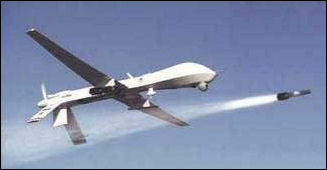
“Other messages sounded a similar theme. At least two came from the head of al-Qaeda’s security unit, a group that had been established to protect against penetrations by informants who might provide targeting tips to the CIA. The group is thought to be behind executions of dozens of suspected informants. In some cases, corpses were found with notes attached declaring that the deceased was an American spy. The unit leader complains “about having a very low budget, a few thousand dollars,” the official said. The letter refers to “ideas” about how to better guard against informants and electronic eavesdropping. But the most obvious solutions, including restricting meetings and movements, would also hamper al-Qaeda’s ability to function.
“Other messages make frequent mention of the organization’s financial hardships, including e-mails in which bin Laden himself complains about the lack of funds. One bin Laden message sent in spring 2010 “instructed a deputy to form a group that would get money through kidnapping and ransom of diplomats,” the U.S. official said. “The term “financial hardship” was used in the message, the U.S. official said.
Al-Qaida After Osama bin Laden’s Death
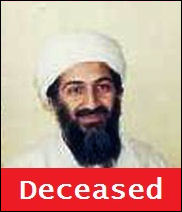
At the time of Osama bin Laden’s death in May 2011, Phil Stewert and William MacLean of Reuters wrote: Nearly Al Qaeda has fragmented into a globally-scattered network of autonomous groups in which bin Laden served as an inspirational figure from the core group's traditional Pakistan-Afghanistan base. Counter-terrorism specialists describe a constantly mutating movement that is harder to hunt than in its turn of the century heyday because it is increasingly diffuse — a multi-ethnic, regionally dispersed and online-influenced hybrid of activists. [Source: Phil Stewert and William MacLean, Reuters, May 2, 2011]
While this network remains a threat, the core al Qaeda leadership has been weakened by years of U.S. drone strikes in Pakistan. It has not staged a successful attack in the West since London bombings that killed 52 people in 2005. Al Qaeda has also been hurt ideologically by uprisings in the Arab world by ordinary people seeking democracy and human rights — notions anathema to bin Laden, who once said democracy was akin to idolatry as it placed man's desires above God's. [Source: Phil Stewert and William MacLean, Reuters, May 2, 2011]
A year after Osama bin Laden’s death, Associated Press wrote: “Al-Qaida is hobbled and hunted, too busy surviving for the moment to carry out another Sept. 11-style attack on U.S. soil. But the terrorist network dreams still of payback, and U.S. counterterrorist officials warn that, in time, its offshoots may deliver.A decade of wars in Iraq and Afghanistan that has cost the U.S. about $1.28 trillion and 6,300 U.S. troops' lives has forced al-Qaida's affiliates to regroup, from Yemen to Iraq. Bin Laden's No. 2, Ayman al-Zawahri, is thought to be hiding, out of U.S. reach, in Pakistan's mountains, just as bin Laden was for so many years.[Source: Kimberly Dozier, Associated Press, April 30, 2012]
“Afghanistan is the temporary home to up to 100 al-Qaida fighters at any single time, U.S. officials say, adding that a steady series of U.S. special operations raids is essential to keeping them out. With the withdrawal of U.S. forces, U.S. counterterrorism officials fear al-Qaida could return. By the numbers, al-Qaida's greatest presence is still greatest in Iraq, where intelligence officials estimate up to a 1,000 fighters have refocused their campaign from striking now-absent U.S. troops to hitting the country's Shiite-dominated government.
Yemen's al-Qaida of the Arabian Peninsula (AQAP) is becoming a major draw for foreign fighters as it carves out a stronghold in the south of the country, easily defeating Yemeni forces preoccupied battling tribal and political unrest. The White House recently agreed to expanded drone strikes to give the CIA and the military greater leeway to target militant leaders. This al-Qaida group has been a major threat since 2009, when one of its adherents tried to bring down a jetliner over Detroit. Al-Qaida affiliates such as al-Shabab in Somalia are struggling to carry out attacks in the face of a stepped up CIA-U.S. military campaign, and a loss of popular support after blocking U.N. food aid to some 4 million starving Somalis, officials say. But the group is kept afloat by a stream of cash, partly from piracy and kidnapping of the Somali coast.
See Separate Article AYMAN RAI AL-ZAWAHIRI AND AL-QAIDA factsanddetails.com
Image Sources: Wikimedia Commons
Text Sources: New York Times, Washington Post, Los Angeles Times, Times of London, The Guardian, National Geographic, The New Yorker, Time, Newsweek, Reuters, AP, AFP, Wall Street Journal, The Atlantic Monthly, The Economist, Global Viewpoint (Christian Science Monitor), Foreign Policy, Wikipedia, BBC, CNN, NBC News, Fox News and various books and other publications.
Last updated July 2012

